TOYOTA AVALON 2012 XX40 / 4.G Owners Manual
Manufacturer: TOYOTA, Model Year: 2012, Model line: AVALON, Model: TOYOTA AVALON 2012 XX40 / 4.GPages: 580, PDF Size: 9.33 MB
Page 201 of 580
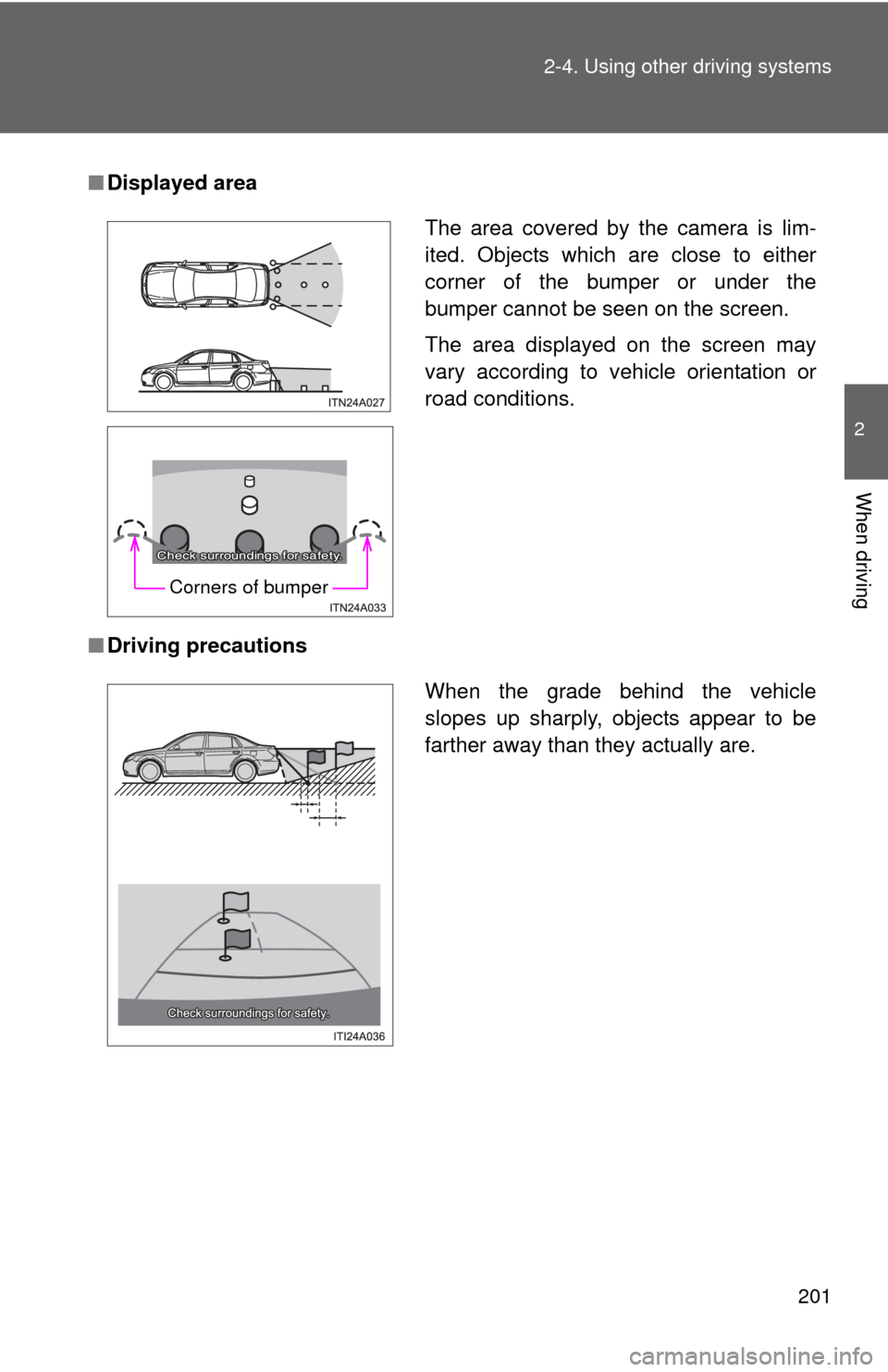
201
2-4. Using other
driving systems
2
When driving
■Displayed area
■ Driving precautions
The area covered by the camera is lim-
ited. Objects which are close to either
corner of the bumper or under the
bumper cannot be seen on the screen.
The area displayed on the screen may
vary according to vehicle orientation or
road conditions.
Corners of bumper
When the grade behind the vehicle
slopes up sharply, objects appear to be
farther away than they actually are.
Page 202 of 580
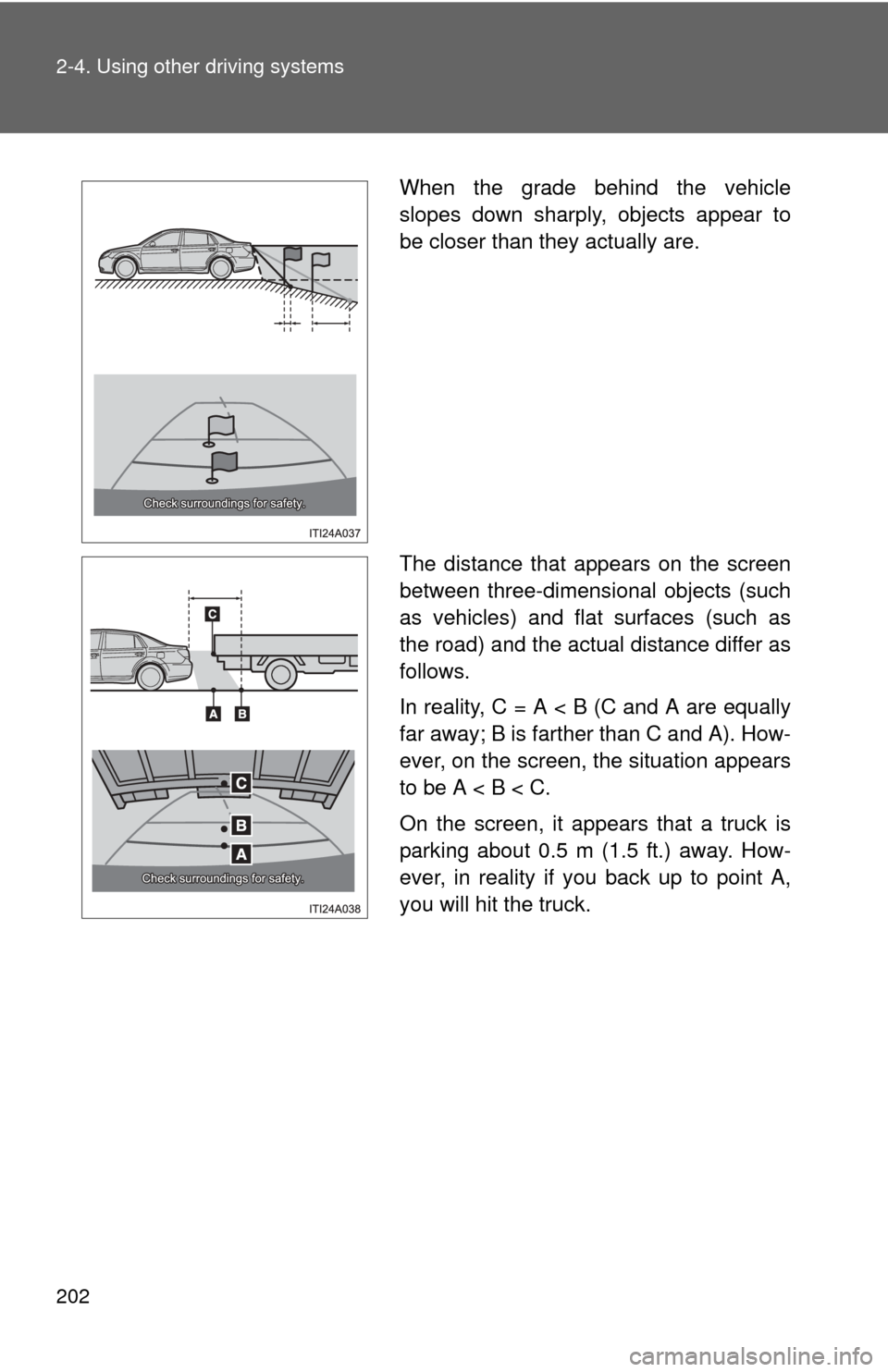
202 2-4. Using other driving systems
When the grade behind the vehicle
slopes down sharply, objects appear to
be closer than they actually are.
The distance that appears on the screen
between three-dimensional objects (such
as vehicles) and flat surfaces (such as
the road) and the actual distance differ as
follows.
In reality, C = A < B (C and A are equally
far away; B is farther than C and A). How-
ever, on the screen, the situation appears
to be A < B < C.
On the screen, it appears that a truck is
parking about 0.5 m (1.5 ft.) away. How-
ever, in reality if you back up to point A,
you will hit the truck.
Page 203 of 580
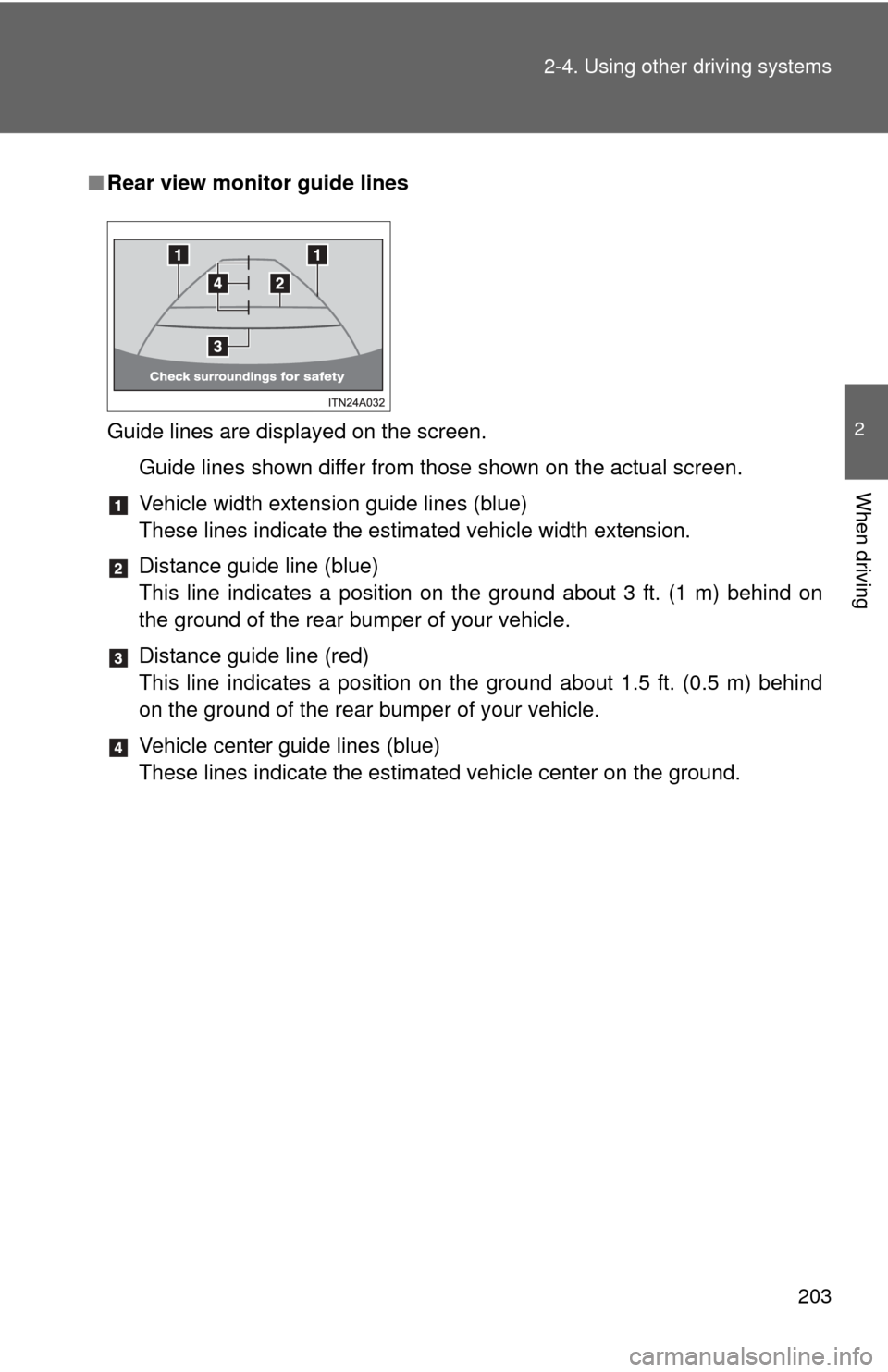
203
2-4. Using other
driving systems
2
When driving
■Rear view monitor guide lines
Guide lines are displayed on the screen.
Guide lines shown differ from those shown on the actual screen.
Vehicle width extension guide lines (blue)
These lines indicate the estimated vehicle width extension.
Distance guide line (blue)
This line indicates a position on the ground about 3 ft. (1 m) behind on
the ground of the rear bumper of your vehicle.
Distance guide line (red)
This line indicates a position on the ground about 1.5 ft. (0.5 m) behind
on the ground of the rear bumper of your vehicle.
Vehicle center guide lines (blue)
These lines indicate the estimated vehicle center on the ground.
Page 204 of 580
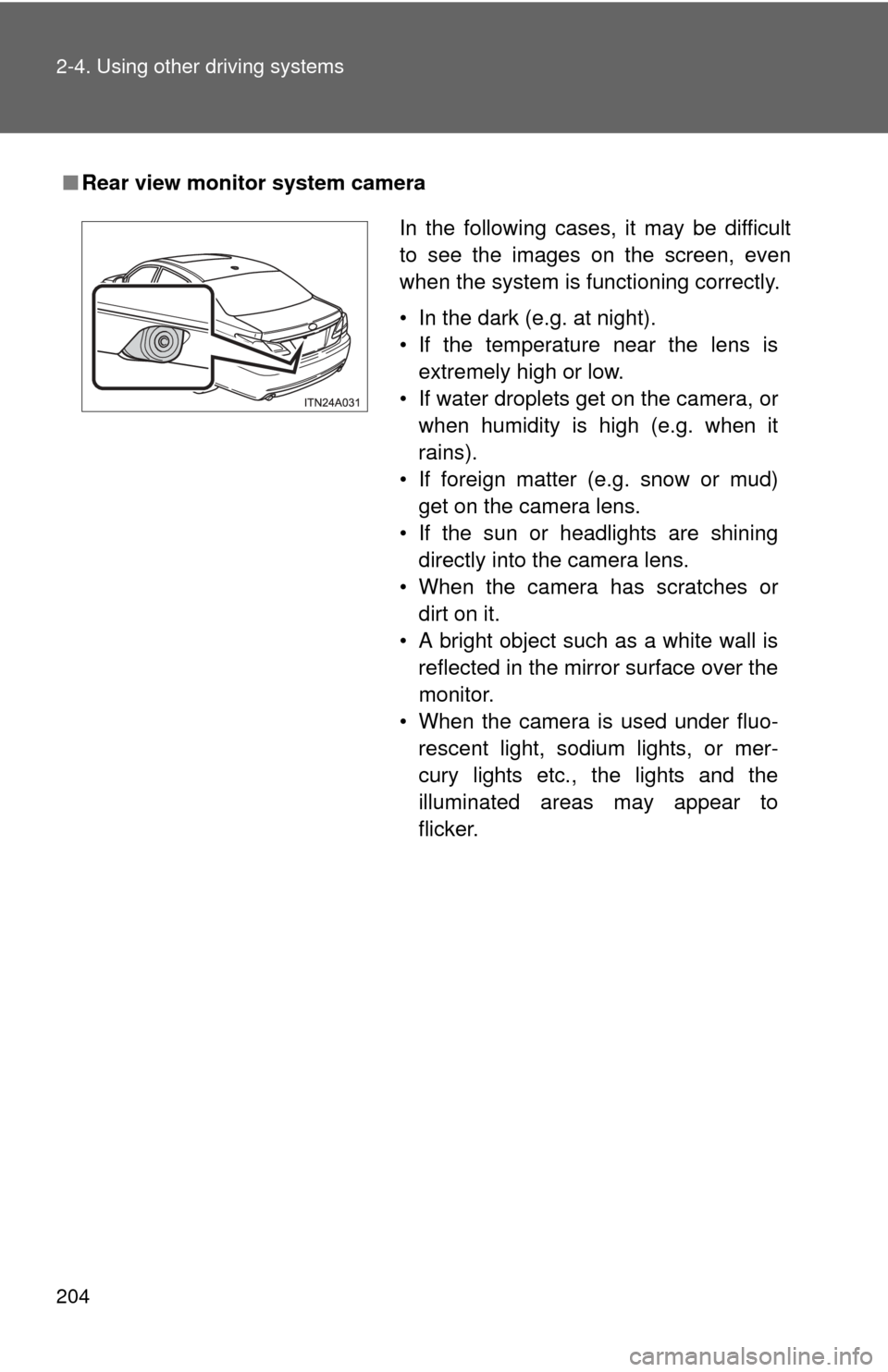
204 2-4. Using other driving systems
■Rear view monitor system camera
In the following cases, it may be difficult
to see the images on the screen, even
when the system is functioning correctly.
• In the dark (e.g. at night).
• If the temperature near the lens is
extremely high or low.
• If water droplets get on the camera, or when humidity is high (e.g. when it
rains).
• If foreign matter (e.g. snow or mud) get on the camera lens.
• If the sun or headlights are shining directly into the camera lens.
• When the camera has scratches or dirt on it.
• A bright object such as a white wall is reflected in the mirror surface over the
monitor.
• When the camera is used under fluo- rescent light, sodium lights, or mer-
cury lights etc., the lights and the
illuminated areas may appear to
flicker.
Page 205 of 580
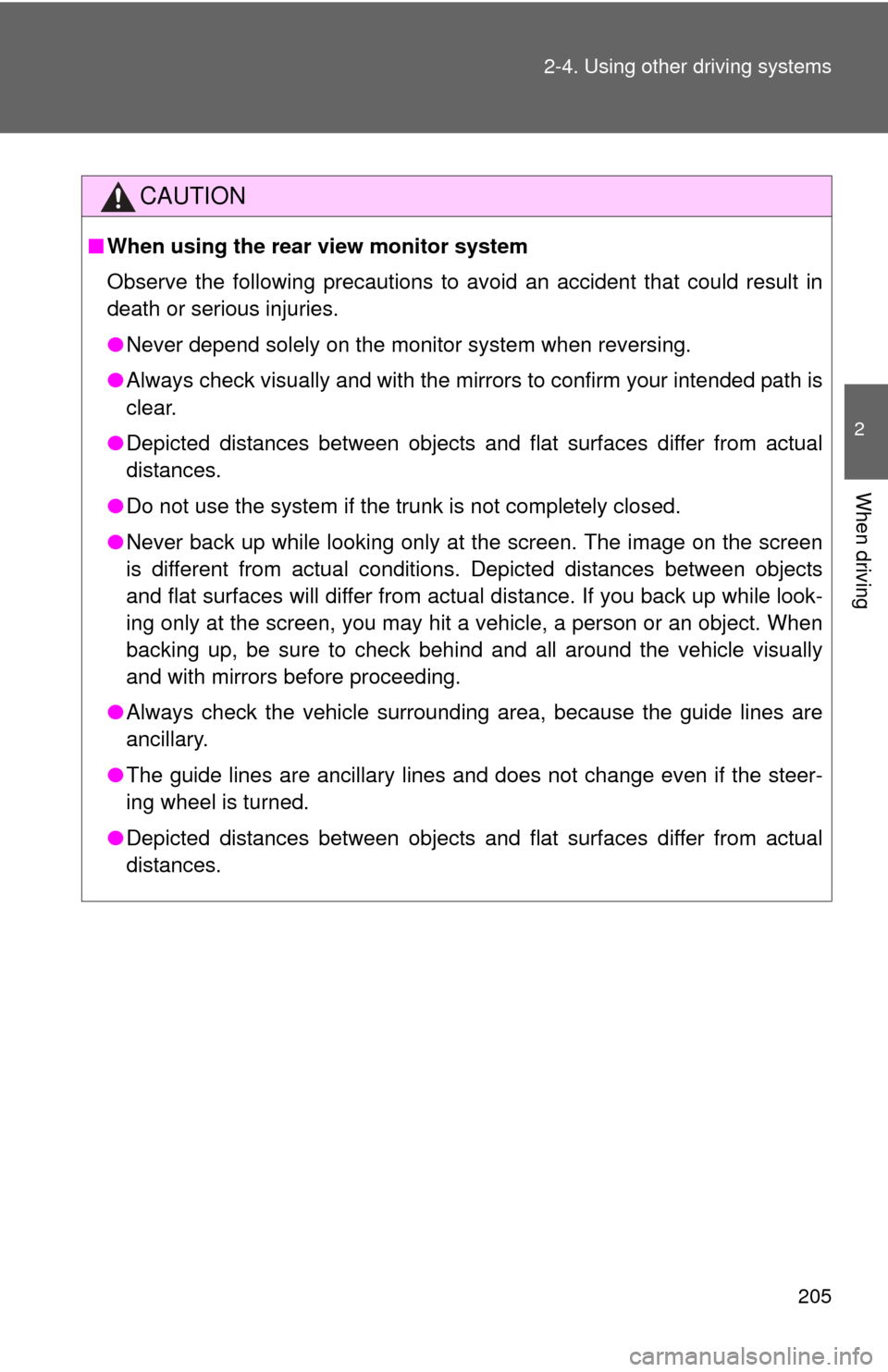
205
2-4. Using other
driving systems
2
When driving
CAUTION
■When using the rear view monitor system
Observe the following precautions to avoid an accident that could result in
death or serious injuries.
●Never depend solely on the monitor system when reversing.
● Always check visually and with the mirrors to confirm your intended path is
clear.
● Depicted distances between objects and flat surfaces differ from actual
distances.
● Do not use the system if the trunk is not completely closed.
● Never back up while looking only at the screen. The image on the screen
is different from actual conditions. Depicted distances between objects
and flat surfaces will differ from actual distance. If you back up while look-
ing only at the screen, you may hit a vehicle, a person or an object. When
backing up, be sure to check behind and all around the vehicle visually
and with mirrors before proceeding.
● Always check the vehicle surroundi ng area, because the guide lines are
ancillary.
● The guide lines are ancillary lines and does not change even if the steer-
ing wheel is turned.
● Depicted distances between objects and flat surfaces differ from actual
distances.
Page 206 of 580
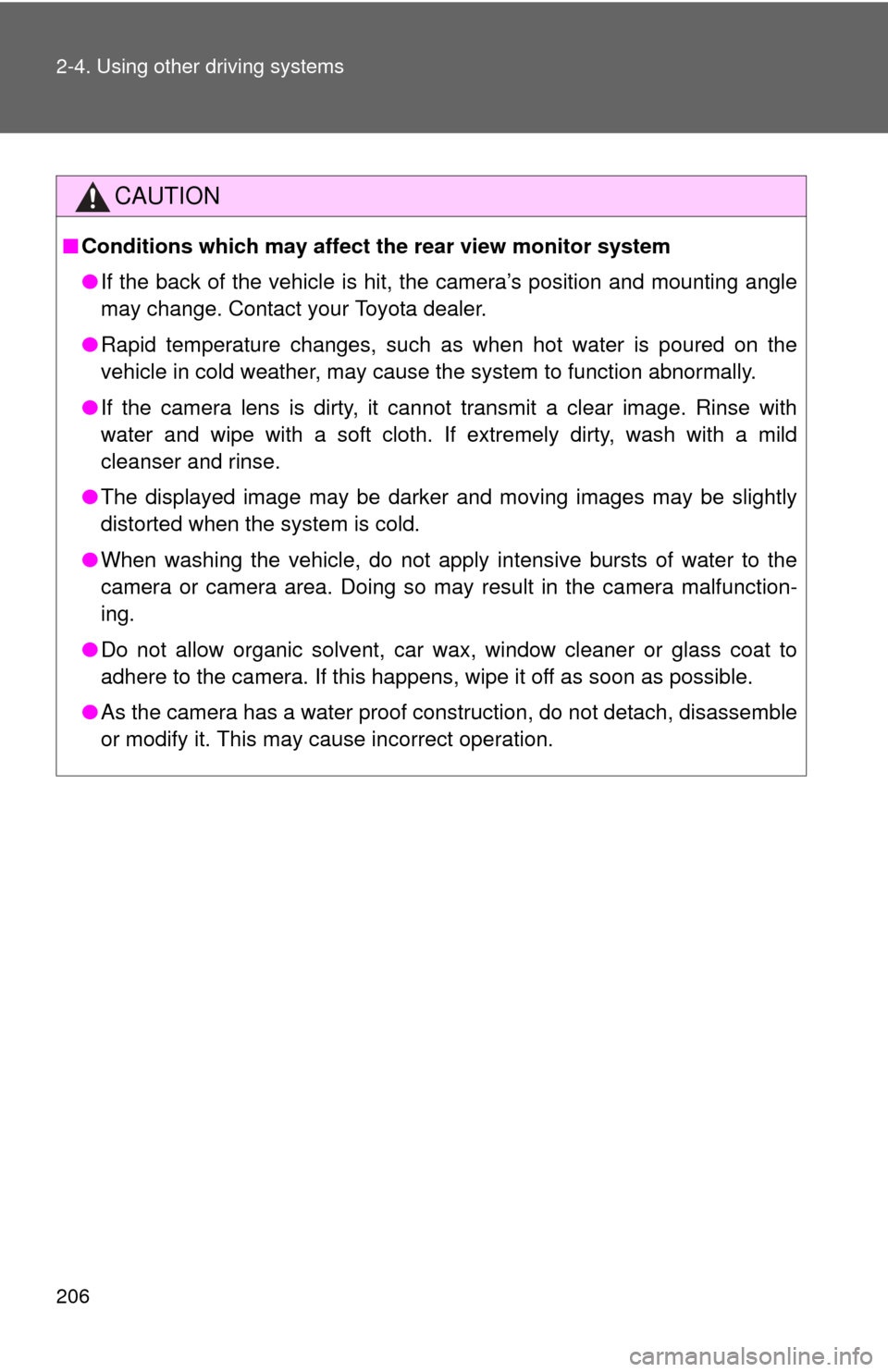
206 2-4. Using other driving systems
CAUTION
■Conditions which may affect the rear view monitor system
● If the back of the vehicle is hit, the camera’s position and mounting angle
may change. Contact your Toyota dealer.
● Rapid temperature changes, such as when hot water is poured on the
vehicle in cold weather, may cause the system to function abnormally.
● If the camera lens is dirty, it cannot transmit a clear image. Rinse with
water and wipe with a soft cloth. If extremely dirty, wash with a mild
cleanser and rinse.
● The displayed image may be darker and moving images may be slightly
distorted when the system is cold.
● When washing the vehicle, do not apply intensive bursts of water to the
camera or camera area. Doing so may result in the camera malfunction-
ing.
● Do not allow organic solvent, car wax, window cleaner or glass coat to
adhere to the camera. If this happens, wipe it off as soon as possible.
● As the camera has a water proof construction, do not detach, disassemble
or modify it. This may cause incorrect operation.
Page 207 of 580
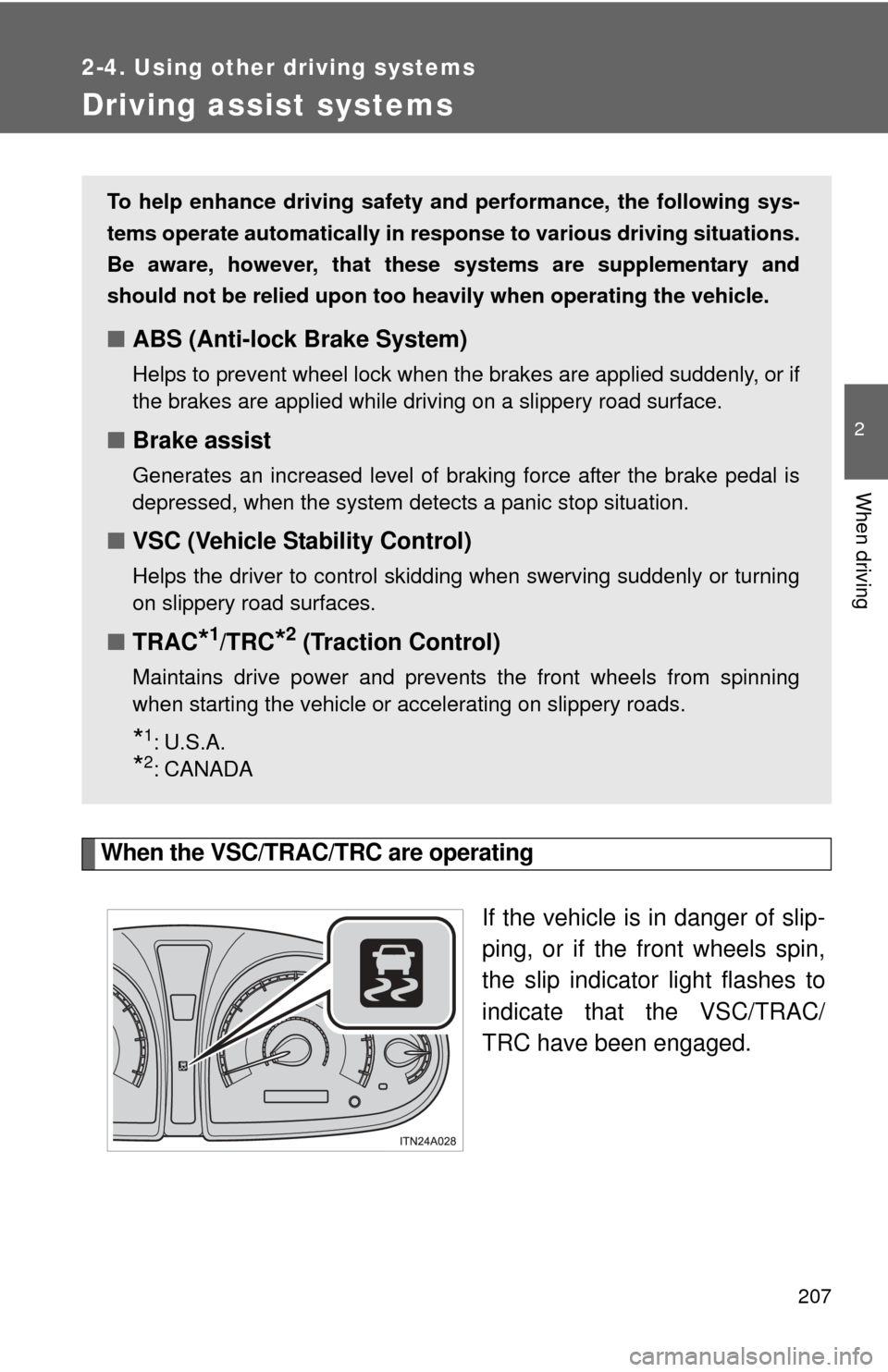
207
2-4. Using other driving systems
2
When driving
Driving assist systems
When the VSC/TRAC/TRC are operatingIf the vehicle is in danger of slip-
ping, or if the front wheels spin,
the slip indicator light flashes to
indicate that the VSC/TRAC/
TRC have been engaged.
To help enhance driving safety and performance, the following sys-
tems operate automatically in res ponse to various driving situations.
Be aware, however, that these systems are supplementary and
should not be relied upon too heavi ly when operating the vehicle.
■ABS (Anti-lock Brake System)
Helps to prevent wheel lock when the brakes are applied suddenly, or if
the brakes are applied while driving on a slippery road surface.
■Brake assist
Generates an increased level of braking force after the brake pedal is
depressed, when the system detects a panic stop situation.
■VSC (Vehicle Stability Control)
Helps the driver to control skidding when swerving suddenly or turning
on slippery road surfaces.
■TRAC*1/TRC*2 (Traction Control)
Maintains drive power and prevents the front wheels from spinning
when starting the vehicle or accelerating on slippery roads.
*1: U.S.A.
*2:CANADA
Page 208 of 580
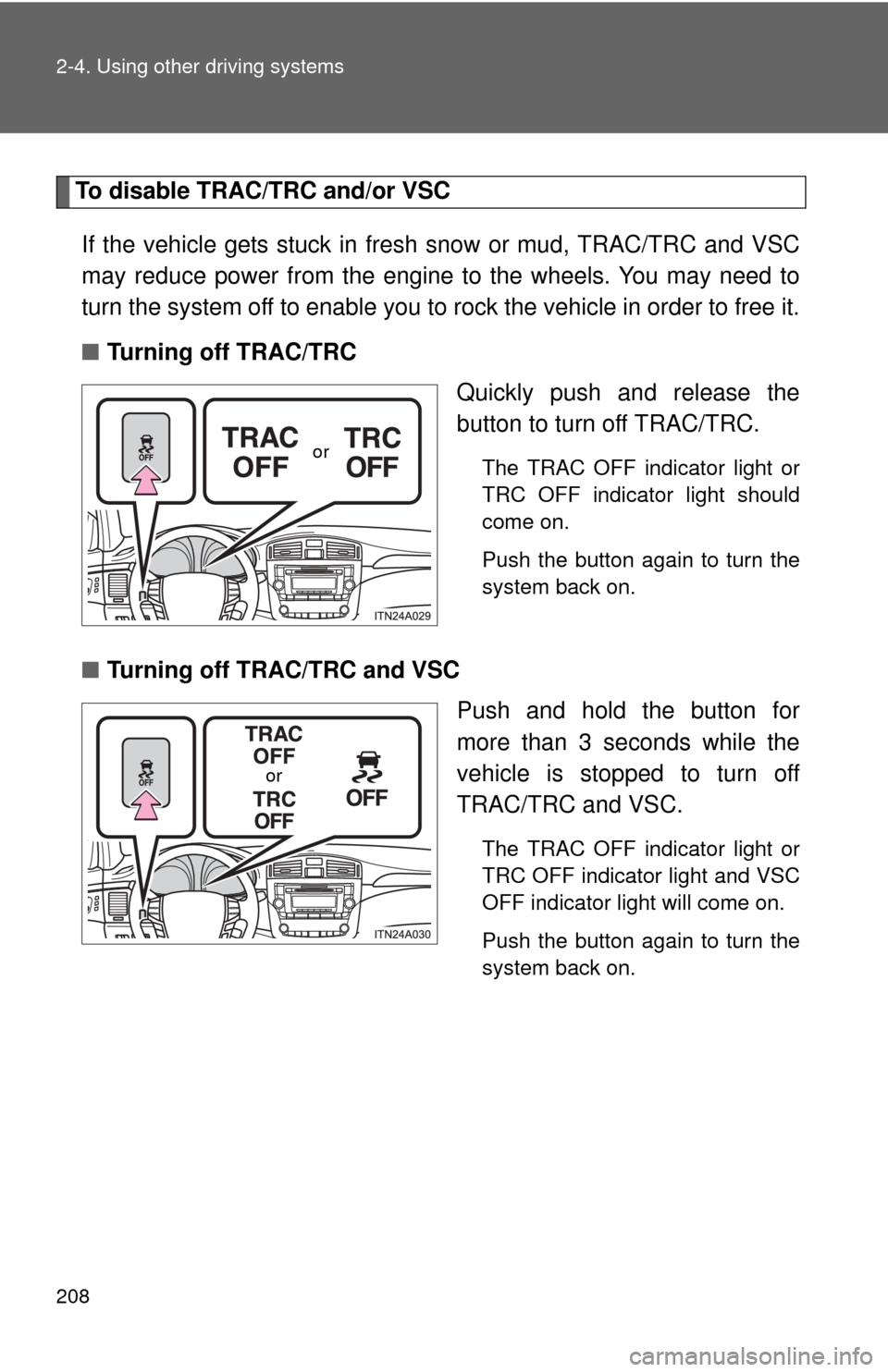
208 2-4. Using other driving systems
To disable TRAC/TRC and/or VSCIf the vehicle gets stuck in fresh snow or mud, TRAC/TRC and VSC
may reduce power from the engine to the wheels. You may need to
turn the system off to enable you to rock the vehicle in order to free it.
■ Turning off TRAC/TRC
Quickly push and release the
button to turn off TRAC/TRC.
The TRAC OFF indicator light or
TRC OFF indicator light should
come on.
Push the button again to turn the
system back on.
■Turning off TRAC/TRC and VSC
Push and hold the button for
more than 3 seconds while the
vehicle is stopped to turn off
TRAC/TRC and VSC.
The TRAC OFF indicator light or
TRC OFF indicator light and VSC
OFF indicator light will come on.
Push the button again to turn the
system back on.
or
or
Page 209 of 580

209
2-4. Using other
driving systems
2
When driving
■When the “TRAC OFF” indicator light or “TRC OFF” indicator light
comes on even if the VSC OFF swit ch has not been pressed TRAC or
TRC cannot be operated. Cont act your Toyota dealer.
■ Automatic reactivation of TRAC/TRC and VSC
Vehicles with smart key system
Turning the “ENGINE START STOP” switch off after turning off the
TRAC/TRC and VSC will automatically re-enable them.
Vehicles without smart key system
Turning the engine switch to the “LOCK” position after turning off the
TRAC/TRC and VSC will automatically re-enable them.
■ Automatic TRAC/T RC reactivation
If only the TRAC/TRC is turned off, the TRAC/TRC will turn on when vehicle
speed increases.
■ Automatic TRAC/TRC and VSC reactivation
If the TRAC/TRC and VSC are turned off, the systems will not turn on even
when vehicle speed increases.
■ Sounds and vibrations caused by the ABS, brake assist, VSC and
TRAC/TRC
● A sound may be heard from the engine compartment when the engine is
started or just after the vehicle begins to move. This sound does not indi-
cate that a malfunction has occurred in any of these systems.
● Any of the following conditions may occur when the above systems are
operating. None of these indicates that a malfunction has occurred.
• Vibrations may be felt through the vehicle body and steering.
• A motor sound may be heard after the vehicle comes to a stop.
• The brake pedal may pulsate slightly after the ABS is activated.
• The brake pedal may move down slightly after the ABS is activated.
Page 210 of 580
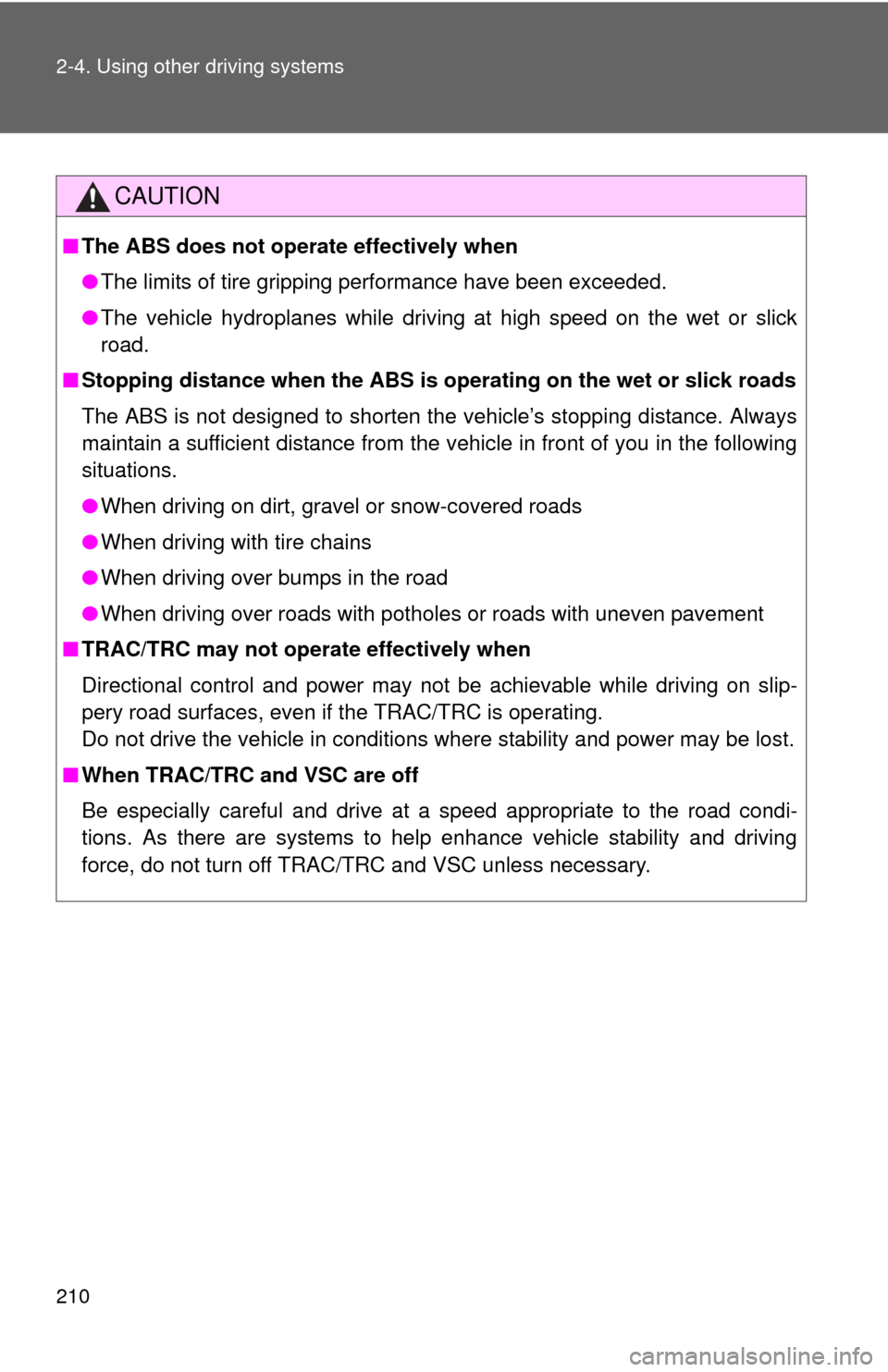
210 2-4. Using other driving systems
CAUTION
■The ABS does not operate effectively when
●The limits of tire gripping performance have been exceeded.
● The vehicle hydroplanes while driving at high speed on the wet or slick
road.
■ Stopping distance when the ABS is ope rating on the wet or slick roads
The ABS is not designed to shorten the vehicle’s stopping distance. Always
maintain a sufficient distance from the vehicle in front of you in the following
situations.
● When driving on dirt, gravel or snow-covered roads
● When driving with tire chains
● When driving over bumps in the road
● When driving over roads with potholes or roads with uneven pavement
■ TRAC/TRC may not oper ate effectively when
Directional control and power may not be achievable while driving on slip-
pery road surfaces, even if the TRAC/TRC is operating.
Do not drive the vehicle in conditions where stability and power may be lost.
■ When TRAC/TRC and VSC are off
Be especially careful and drive at a speed appropriate to the road condi-
tions. As there are systems to help enhance vehicle stability and driving
force, do not turn off TRAC/TRC and VSC unless necessary.